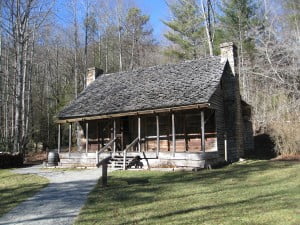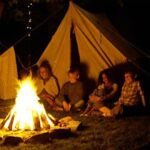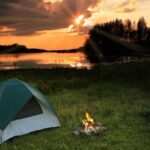by Liz Childers

There is a lot of good that can be said about the convenience of modern camping. If you get to a campsite close to sundown, a lighter and a camping stove ensure you won’t go hungry if you cannot gather firewood quickly enough. And if there’s sudden rain? Incredibly sturdy, waterproof tents give you the peace of mind that your camping trip won’t be ruined.
However, primitive camping skills are also important to know and have. On October 8, the U.S. Department of Agriculture Forest Service hosted “Camping in the Old Style,” an event aimed at showing visitors what those skills were. The Golden Age of Camping re-enactment featured a reconstructed, early 1900s campsite at the Cradle of Forestry in Brevard, N.C.
The Cradle of Forestry is a 6500-acre historic site within the Pisgah National Forest. The Biltmore School of Forestry was founded in 1898 and was the first forestry school in America. Carl A. Schenck, its founder, instituted forest management and conservation techniques in the Pisgah National Forest. These techniques were the first of its kind, and the Cradle of Forestry honors the beginning of forestry conservation.
The Golden Age of Camping happened around the 20th century when city dwellers were first beginning to indulge in camping as a fun form of outdoor recreation. The Pisgah National Forest, which was officially established in 1916, was a young and beautiful camping destination.
For these reasons, it is very appropriate that the Cradle of Forestry hosted “Camping in the Old Style.” Steve Watts, a primitive outdoor skills educator at the Schiele Museum, was the primary presenter. David Wescott, author of Camping in the Old Style, joined him. Along with other trained campers, the two experts presented traditional skills, such as making fire with steel and flint, and demonstrated primitive outdoor gear.
While the event has passed, the Cradle of Forestry is always a great place to visit and learn more about the forests you love and enjoy. The indoor exhibits feature forest history in interactive displays and hands-on exhibits. The Forest Festival Trail lets you literally walk through and learn about Schenck’s forestry work, bygone transportation methods, forest growth, and more. The Biltmore Campus Trail allows a peak into life as a 1900 forestry student in the one-room schoolhouse, general store, cabins, and blacksmith shop.
If you want to further your own low-tech camping skills, pick up a copy of David Wescott’s book. It is widely known as an incredible source for learning about methods of camping from before technology.



